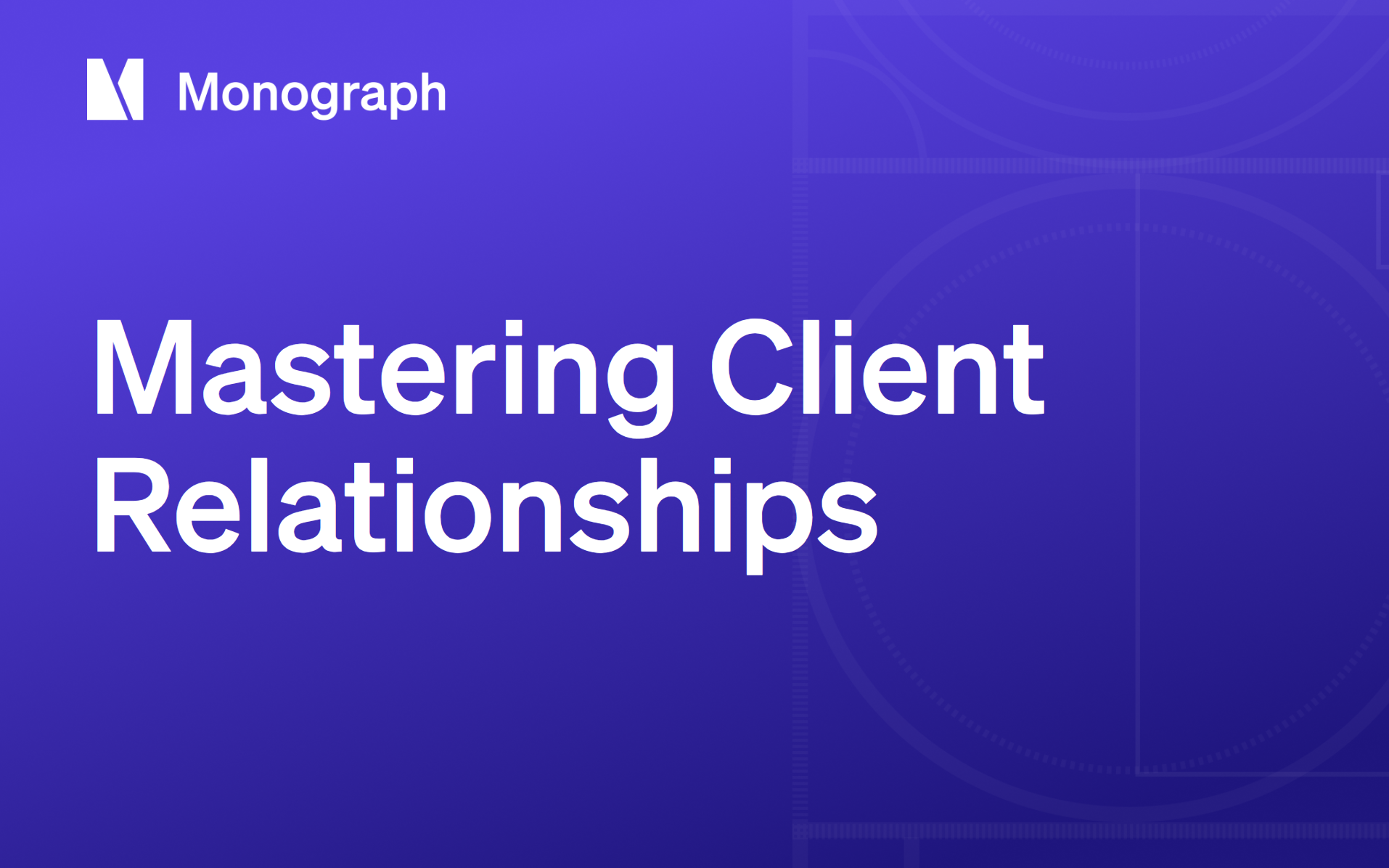Contents
On March 8–10, 2022, Monograph brought together over 1,600 design professionals for our 2nd Section Cut conference.
The 3-day virtual event featured over 46 speakers, 23 sessions, and 10 partners with professionals from architecture firms and AEC tech startups.
We covered a wide range of topics, including:
- Practice operations
- Client experience
- Communication tools
- Digital technology
- Team building
- Sustainability
- And many others
What is Section Cut?
Section cut is a view used in drawing to show an area or hidden part of an object by cutting away or removing some of that object.
We took that concept and applied it to host a conference that takes a deeper look into a problem that is not often discussed: “How do you manage a firm?” aka Practice Operations.

If you missed the event or want to relive your favorite sessions, you can rewatch them here.
We’ve also put together our set of highlights in this article. So let’s dive right in.
1. Transparency is the Key to Better Practice
Transparency is a topic that has been around for a while but lately, it has made its way up across the industry.
People of all levels are demanding to be heard and be part of a team or as it is often referenced “sit at the table.”
There is a movement-building among firm leaders about:
- Digital transformation of practice
- Cultural shifts towards a more transparent firm
- Reimagined leadership role
In the case of Architects FORA, Leah Bayer shared how her firm was able to go against the Great Resignation with a culture of transparency.
While most firm leaders are having a hard time hiring, Leah shared how they got over 300+ applicants in less than 24 hours, leading to 3 high-impact hires—all because of transparency.
“We take into heart every report about what people want in a job and decide to craft a job posting that’s more like a sales pitch…aligning with our value of transparency.”
—Leah Bayer, President at Architects FORA
But hiring goes beyond job postings, Architects FORA is able to build a culture that attracts top candidates by offering a few benefits that speak to their values:
- Remote work across the country
- A day per week for learning and research
- Tech & educational stipends
- Flexible health & retirement plans
- 1 on 1 career development meetings
- Salary transparency based on 3 tiers
All these are based on their belief in equity, flexibility and transparency.
One of Monograph's customers Tom Jacobs from Krueck Sexton Partners openly shared his entire operations and management framework on a Miro board that he called a Firm Operations Cockpit.

Tom noted it’s not only important to be transparent internally with your own team members, but it’s time for all of us to be transparent to each other externally.
He issued a call to action for the entire industry to share their knowledge with other firms to create a better profession for all.
“We have in the A/E industries spent way too many years building walls around our firms. When we know something we won’t share because that’s a competitive advantage. The time for that has run out.”
—Tom Jacobs, Co-Managing Partner from Krueck Sexton Partners
2. Leadership Based on Authenticity
Leadership is often attributed to a particular personality type, but we can often be proven wrong.
At Section Cut, we hear from 2 great leaders, who are practicing authentic leadership both in their unique ways and at different stages in their careers.
First, we heard from CFO, author, and entrepreneur Bolanle Williams-Olley, who has been in the AEC industry for over 15 years.
In her conversation Creating BOLD Possibilities, she explains how 61% of successful companies define themselves as successful based on their performance.
Still, revenue shouldn’t be the only measure to be used.
“Building a successful bold firm involves building bold teams, which ultimately starts with a bold leader.”
—Bolanle Williams-Olley, CFO at Mancini Duffy
Getting this perspective from someone in a C suite position illustrates how vital transparency and team building is.
Joann Lui’s conversation was also one a lot of us can relate to.
She explains how she was once forgotten for a raise and her struggles with self-doubt and fear of judgment.

Through her personal branding framework, she is now able to be a leader that shows vulnerability and authenticity to lift others up.
She encourages all architects to focus less on what other people think about them and be proud of what you have accomplished along the way.
“Focus less on the impression you're making on others and more on the impression you're making on yourself.”
—Joann Lui, Personal Brand Strategist & Sr Content Strategist at Monograph
3. Monograph Unlocks Invoicing as Client Experience
We opened the 2nd day of Section Cut by announcing our new invoicing workflow for architects.
Invoicing is a crucial moment in a firm's client experience that’s too often colored by a lack of clarity and alignment.
Here at Monograph, we recognize that while design work is extremely important to architects, it’s also important to get paid for that work.
We shared the results from our mission to make invoicing as painless and frictionless as possible—for clients and architects.
Pete Indelicato, our Head of Products, walked us through the new invoicing workflow within Monograph.
From invoice builder, invoice designer, and project financials, you can learn more about those updates here.
4. Technology and Systems Make Us Work Smarter
Adopting new technologies is part of evolving and being competitive in this rapidly changing market.
But as we’re implementing all these new ideas and methods into our firm, we need to better grasp what is going on in our surroundings.
Maximizing our efficiency at work can be accomplished by different means; one of these is process automation, and this is a concept across all industries, not just the A/E.
For example, Cottage is an ADU firm committed to solving housing affordability by leveraging technology through:
- Process automation
- BIM framework
- Their tech software

Using these technologies helped them:
- Unlock unprecedented scale in custom home design
- Liberate their designer bandwidth for creative problem solving
- Offer a tailored homeowner experience for any client type
Another way to introduce technology and facilitate our lives is by using Artificial Intelligence (AI) Systems that can oversee the various information we put in our applications.
Evelyn Lee from Practice Architecture shares with us a scenario in designing the business side of architecture.
She showed us how to bring together all of these data plants into one, so that you can make better decisions about your business and also supports your daily agenda setting. This is where practice is going.
Almost 50% of the architectural fees for the design phase is spent on design development and construction documents.
Most firms lose revenue at this stage while dealing with:
- Rushed deadlines
- Poor quality of work
- Unhappy clients when asking for additional fees
To help us work more efficiently during these design phases, Aya Shlachter, CEO, and Mike George, Business Growth Strategist from MGS Global Group discussed how to manage the project delivery process through their organization systems and operations.

They also shared their recommendations from team setup and process improvements to the consultants you need to manage operations and keep things running smoothly.
5. What Do the Next Generation of Architects Want? Values
The next generation of architects from AIAS hosted a panel on education around operations with George Valdes, our Head of Marketing at Monograph.
These young professionals emphasized that the business side of running a practice should be included more in the curriculum.
They also think that high schoolers should have guidance before taking the leap on what architecture is really about.
We also recognized that the next generation of architectural students are much more driven by their values when they’re looking for a job.
They suggest students to ask questions like:
- What is the culture like?
- What opportunities do they offer for mentoring?
- What programs do you use regularly?
- How does your team collaborate?
The future has spoken and it looks good.
What’s Your Favorite Moment?
Those were just some of Section Cut’s SS22 virtual conference highlights. Don’t forget to rewatch the sessions on our YouTube channel or visit our Section Cut visioning board, where you can see comments and a summary of what section cut was all about.
If you are interested in getting more insights into Practice Operations, you can tune into our weekly Best Practice Webinars where we interview firms on how they run their practice.
See you at the next Section Cut.




